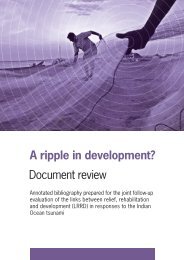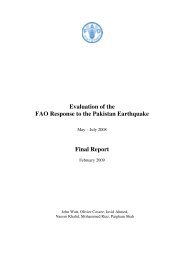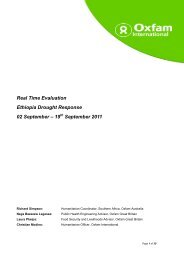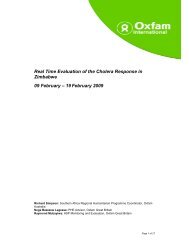Inter-Agency Real Time Evaluation of the Humanitarian ... - alnap
Inter-Agency Real Time Evaluation of the Humanitarian ... - alnap
Inter-Agency Real Time Evaluation of the Humanitarian ... - alnap
Create successful ePaper yourself
Turn your PDF publications into a flip-book with our unique Google optimized e-Paper software.
General recommendations:<br />
IA RTE <strong>of</strong> <strong>the</strong> humanitarian response to Pakistan’s 2010 Floods crisis<br />
I) NDMA/PND/Line Departments, with clusters, must roll out a joint recovery needs assessment.<br />
On this basis <strong>the</strong> NDMA/PDMA, with line departments and UN agencies (led by UNDP) must<br />
develop a joint early recovery and rehabilitation plans according to different geographical area<br />
needs and dynamics. To do so:<br />
a) HC/RC should streamline coordination and Early Recovery Working Group should be<br />
made functional at national, provincial and district levels.<br />
b) NDMA, with <strong>the</strong> relevant government authorities and HCT, will <strong>the</strong>matically regroup<br />
clusters to specific phases <strong>of</strong> <strong>the</strong> emergency, contextual (provincial) realities and<br />
reviewed early plans.<br />
c) NDMA, with UNDP and OCHA, must plan progressive phase out <strong>of</strong> Multan, Hyderabad<br />
and Sukkur hubs by ensuring:<br />
d) That provincial coordination is brought within <strong>the</strong> PDMA in Karachi and Lahore, while<br />
ensuring operational coordination is maintained at district level<br />
e) Donors should provide flexible funding commensurate to priorities outlined in joint<br />
recovery and rehabilitation plans.<br />
f) Support and streng<strong>the</strong>ned emphasis on disaster management and preparedness is<br />
needed, <strong>the</strong>refore: UNDP, with OCHA and cluster leads, must support NDMA’s Disaster<br />
Management Plan and with specific emphasis on:<br />
� Building up national capacities at provincial, district and local levels.<br />
� Developing specific contingency plans for areas at risk.<br />
� Streng<strong>the</strong>ning cooperation between NDMA, PDMA and DDMA.<br />
� Defining <strong>the</strong> role <strong>of</strong> clusters in future disasters<br />
� Introducing standard assessment formats and methodology, based on new IASC<br />
guidelines.<br />
� Defining minimum assistance standards for disaster response in Pakistan<br />
(considering type <strong>of</strong> disaster, scale and length, as well as pre‐existing capacities<br />
and vulnerabilities.<br />
� Implementing geographic area based responses in future disasters <strong>of</strong> similar<br />
scale<br />
II) The UN must reduce transaction costs UN agencies and IPs produce results<br />
commensurate to <strong>the</strong> level <strong>of</strong> funding received (i.e. through unit cost analysis). HCT members<br />
will ensure that response is monitored and results are shared in a transparent fashion. To do so:<br />
Riccardo Polastro, Aatika Nagrah, Nicolai Steen and Farwa Zafar<br />
59
















